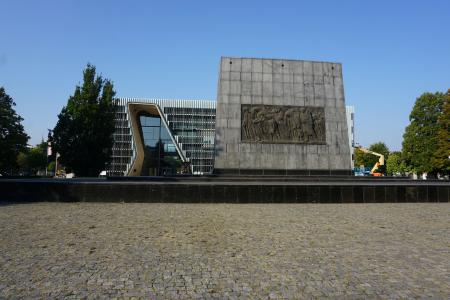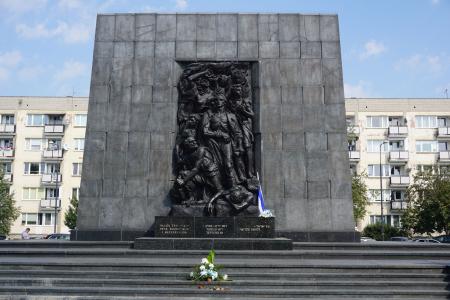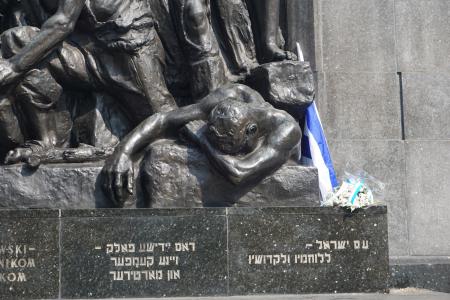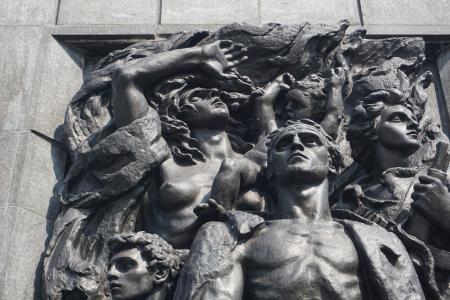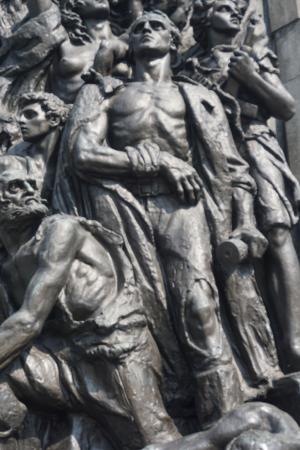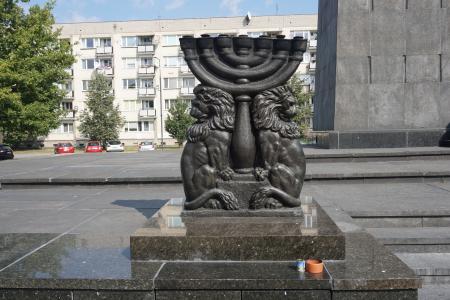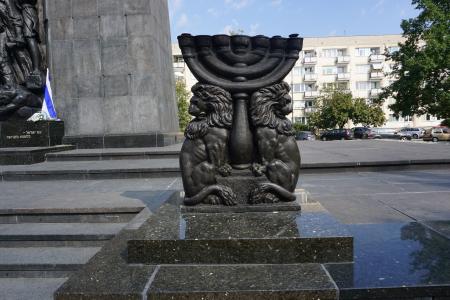Obj. ID: 33307
Memorials Monument to the Ghetto Heroes in Warsaw, Poland, 1948

Name of Monument
Monument to the Ghetto Heroes
Who/What is Commemorated?
Jewish fighters of the Warsaw Ghetto and Jewish victims of the Ghetto
Description
The monument stands atop a wide platform set on the edge of a large, paved square. When dedicated in 1948, the monument stood alone amidst and atop the rubble of the Ghetto. Now the monument is surrounded by apartment buildings of the 1950s, and the POLIN Museum built in 2013. The entrance of the museum faces the monument, and the museum building blocks the monument from a large open park, from which it was formerly visible.
The platform for the monument is 30 m. wide, and 16 m. deep. It is split in the middle by 11 m. wide stairs of five low steps, each 19 cm. high. The steps are centered on the monument. Flanking the steps are identical bronze sculptures of menorahs supported by lions, both traditional Jewish symbols. Each menorah is on a granite base set on the level of the top step. These bases are 96 cm. wide, 39 cm. deep, and 17 cm. high. Each bronze is 1.39 meters tall.
Set back further are two additional low steps, creating a smaller platform from which the monument rises as an isolated wall, 9 meters wide and 2.93 meters deep at its base. From the uppermost step, the monument sits on a 40 cm high base, and then tapers slightly as it rises a further 7.4 meters. The wall consists of alternating courses of 1 meter and 60 cm. high grey granite blocks (or slabs).
A large bronze high-relief figurative sculpture is set in the middle of the wall, this is a focal point of the entire complex, and the dramatic climax to the approach to the monument from across the plaza. The bronze relief is 2.75 meters wide at its base and rises 5.8 meters. The relief depicts the uprising as a tableau of seven figures, centered around the central figure of Mordecai Anielewicz, who is surrounded by fellow fighters of various ages.
“Each grasps a weapon of the sort found in the Ghetto: a muscular prophet figure on one knee picks up a rock, a young boy at the left clutches A dagger; A young woman at the right cradles A Kalashnikov rifle; the leader Anielewicz clenches a homemade grenade. Even the mother engulfed by flames raises her right arm defensively, as does the baby in her other arm. All are vulnerably exposed none has armor or protective clothing of any sort, only as chief of sculpted muscle. As others have noted, in her bared breast and pose, the woman clearly recalls Delacroix’s Liberte and, by extension, the revolutionary insurrection she has come to symbolize in France. In his bare chest, tattered clothes, and rolled up sleeves, clutching his grenade almost like a hammer, Rapoport’s Anielewicz is unmistakably proletarian, marching forth as both worker and partisan to lead his fighters.” (Young, 1993, p. 174)
The eastern part of the monument shows the persecution of Jews at the hands of the Nazi German oppressors. A low bas-relief of Jewish figures being marched out of the Ghetto by German soldiers is carved directly into the granite, in a relief 2.6 meters tall and 5.8 m wide
“Twelve stooped and huddled figures embody archaic, archetypal Jews in exile. Only three Nazi helmets and two bayonets barely visible in the background distinguished this expulsion from any other. Eyes to the ground, all trudge resignedly to their fate --except a rabbi holding a Torah scroll in one arm, who looks up and reaches to heaven as if to beseech God.” (Young, 1993, p. 174)
“That relief is also rooted in the Jewish social art of the turn of the 20th century - works like Maurycy Minkowski's Jews Leaving the Town (ca 1910) and Jacob Weinles' Jews Fleeing a Pogrom (ca. 1914); both works lost or destroyed in the Holocaust; and Samuel Hirszenberg's Exile (1904)and The Black Banner (1905).” (Gruber, 2009).
On the front of the monument is a dedication inscribed on dark granite in Hebrew, Yiddish, and Polish: “To the Jewish People – Its Heroes and Its Martyrs.”
Inscriptions
On the front of the monument, in Hebrew:
ישראל -
ללוחמיו ולקדושיו
The same text, in Yiddish:
דאס יידישע פאלק -
זיינע קעמפער
און מארטירער
The same text, in Polish:
NARÓD ŻYDOWSKI-
SWYM BOJOWNIKOM
I MĘCZENNIKOM
Translation: To the Jewish People – Its Heroes and Its Martyrs
1997 plaques attached to side of base, in Polish:
Prace zostały wsparte finansowo
przez Fundacje Współpracy Polsko - Niemieckiej
ze środków Republiki Federalnej Niemiecl ipiec 1997
Translation: The work was financially supported by the Foundation for Polish-German Cooperation from the funds of the Federal Republic of Germany, September 1997
1997 plaques attached to side of base, in German:
Renovierungsarbaiten wurden von der
Stiftung für deutsch-polnische Zusammenarbeit
Aus Mitteln der Bundesrepublik Deutschland
finanziell unterstützt Juli 1997
Translation: Renovation work was carried out by the Foundation for German-Polish Cooperation With funds from the Federal Republic of Germany financially supported // July 1997
1997 plaques attached to side of base, in Polish:
Renowacja pomnika wykonana została z inicjatywy
i przy wsparciu finansowym
Fundacji SHALOM lipiec 1997
Translation: The renovation of the monument was carried out on the initiative and with financial support SHALOM Foundation, July 1997
1997 plaques attached to side of base, in English:
Renovation of the monument was initiated
And financially supported by the
SHALOM Foundation July 1997
Commissioned by
Warsaw Jewish Committee
sub-set tree:
| Square of the Ghetto Heroes of Warsaw, Ludwika Zamenhofa, 00-153
W | Wall
H | Heraldic composition | Supporters | Two lions
J | Jew, image of | Mordechai Anielewicz, image of
R | Rabbi
P | Prayer | Embracing the Torah scroll
J | Jews
S | Soldier | Wehrmacht Soldier
|
Labradorite Granite
Concrete
Platform 30m x 16 m.; stairs 11 m wide.
Menorah bases 96 cm. wide, 39 cm. deep, and 17 cm. high.
Each bronze menorah 1.39 meters tall.
Wall/monument 7.8 m. tall (from platform), 9 m. wide and 2.93 m. deep at its base
w/ alternating courses of 1 meter and 60 cm. high granite blocks
Bronze relief 2.75 m wide at base, 6 m high
Rear of monument, final march bas-relief
5.8 m wide
2.6 m high
Set in wall 2 m. from base
On the right side of the relief's base: NATAN RAPOPPO[RT]
James Young presents the history of monument in detail in the book, The Texture of Memory (1993), summarized here:
The first call for a monument to the April 1943 Warsaw Ghetto Uprising came a year later by the poet Julian Tuvim in his manifesto “We, Polish Jews …” Sculptor Nathan Rapoport probably read the Russian version of the poem published in 1944 by the Union of Polish Patriots. And vowed to create a monument to the Uprising, but his efforts were suppressed by Soviet authorities. The Polish-born Jewish artist had escaped to the Soviet Union and was working for the Red Army at the time, as a sculptor of Soviet heroes. Before he knew the details of the uprising, he conceived a heroic monument that drew on elements of his classical training, Jewish tradition, and the Social Realist style preferred by Stalin and the Soviet regime. Rapoport's earliest designs were criticized as being too Stalinist, and by Soviet arbiters of taste as being too “nationalistic,” by which was meant “too Jewish.”
Rapoport continued to work on models for the monument until 1946 when he was repatriated to Warsaw and design which he had brought with him was almost immediately approved by the Warsaw Jewish Committee. Rapoport insisted that the proper location for the monument would be where the uprising had begun. Amidst the ruins, the committee had already marked the site of the Anielewicz bunker with a large red sandstone disc in a flower bed with an inscription dedicated to the Jewish fighting organization. They agreed to build the new monument nearby. The committee and artist spent a year raising funds before taking the project to the Warsaw Arts Committee, which delayed a decision, because of political uncertainly, and because at the time it was still uncertain to what extent Warsaw would be rebuilt at all, and if so, whether building materials could be spared for a monument. Finally, the committee accepted the proposal on the condition that the monument be unveiled on the 5th anniversary of the uprising on April 19, 1948, less than a year away. Significantly, the new State of Israel declared its independence a month later, on May 14, 1948
Rapoport moved to Paris to work on the monument and deliberately isolated himself from contemporary art trends. He used Jews from Palestine living in Paris as his models, to create, in his own words, “a clearly National Monument for the Jews, not a Polish monument. I wanted to show the Polish people who we really were." At the same time, Mark Leon Suzin, a survivor and an architect, was commissioned to design and construct the base of the monument in Warsaw. He intended to clear the mountain of rubble from the monument and to anchor the monument solidly in the ground, but without mechanical equipment this was impossible, Instead, Suzin poured tons of concrete and reinforcement over the ruins to create a stable base. Subsequent settling of the rubble, however, would cause cracks in the monument’s granite base requiring reconstruction by municipal authorities in 1959.”
“At the end of 1947, while the foundry was casting the bronze part of the sculpture in Paris, Rapoport and Suzin traveled to Sweden in search of granite for the monument's retaining wall. The Jewish Agency in Stockholm directed them to the best quarry in the area, where they discovered a huge cache of perfectly cut labradorite granite blocks, ready to be shipped they were informed that these had been ordered during the war by Arno Brecker the great German sculptor for a monument in Berlin to commemorate Hitler's victory. Satisfied that the granite was in every way perfect for their own monument, sculptor and architect sent directly to Warsaw.” (Young, 1993, p. 168)
In March 1948 the bronze sculptures were unveiled in Paris to near unanimous acclaim. Rapoport was afraid the 90 pieces of statuary might be stopped by Soviet soldiers at the border so they were shipped by waterway to Warsaw and arrived in the last week of March 1948 along with the cut stone from Sweden. Polish sculptors, working from Rapoport's model, had only a few weeks to carve the bas-relief into the backside of the monument. When Rapoport arrived in Warsaw they had not finished, so he went to work helping the five sculptors.
At the unveiling Rabbi Driestmann of Poland recited the Mourner’s Kaddish and he was joined by most of the 12,000 survivors visiting Jewish dignitaries and local politicians and spectators quote according to witnesses and reporters, hundreds of flaming red banners of socialist and communist youth groups flutter together overhead with blue and White Star of David banners listed by Jewish and Zionist groups." After the prayers the monument was unveiled when Yitzhak Zuckerman a surviving leader of the uprising began to speak.
The monument is a two-sided and, in James Young’s view “represents two Jewish types, each to be viewed separately. But in addition to the narrative movement on each side of the wall (the martyrs marching laterally right to left, the heroes ascending vertically), I detect a movement between opposing sides within the core of the wall itself, from dark side to light. For as we see from a side view of the monument, the engraved martyrs recede into the granite and become invisible, as if absorbed into the stone. On the western side facing the open square, however, the heroes’ profiles stand out in distinct relief period in this movement between sides, the ancient type seems to pass into the shaded wall only to emerge triumphantly out of the other side into the western light: one type is literally recessive, the other emergent.” (Texture of Memory, 1993, p. 174)
Donner, Batia, Nathan Rapoport: A Jewish Artist, (Jerusalem: Yad Yitzhak Ben-Tzvi and Givat Haviva: Yad Yaari, 2014) [Hebrew]
Elsby, Liz, “Rapoport's Memorial to the Warsaw Ghetto Uprising – a Personal Interpretation,” Yad Vashem website., https://www.yadvashem.org/articles/general/warsaw-memorial-personal-interpretation.html (accessed June 2, 2024)
Gruber, Samuel D. “Poland: Monuments and Memory in Warsaw," Samuel Gruber’s Jewish Art and Monuments. June 16, 2009., https://samgrubersjewishartmonuments.blogspot.com/2009/06/poland-monuments-and-memory-in-warsaw.html (accessed December 23, 2021)
Piątkowska, Renata, "Żywa Pamięć" Pomnik Bohaterów Getta Natana Rapoporta,” in Rzeźba w architekturze, ed. Katarzyna Chrudzimska-Uhera and Bartłomiej Gutowski (Warsaw: Wydawnictwo Uniwersytetu Kardynała Stefana Wyszyńskiego, 2008).
Rapoport, Nathan, “Memoir of the Warsaw Ghetto Monument,” in The Art of Memory: Holocaust Memorials in History, ed. James Young (Munich: Prestel, 1994), 103–107.
Tanikowski, Artur, “Zabytek hańby naszych wrogów, a chwały naszych umęczonych bohaterów: Urodziny Pomnika Bohaterów Getta," Cwiszn, no. 1/2 (2013): 112–118., http://www.cwiszn.pl/files/files/Tanikowski.pdf (accessed June 2, 2024)
Yaffe, Richard. Nathan Rapoport Sculptures and Monuments (New York: Shengold, 1980).
Young, James. The Texture of Memory: Holocaust Memorials and Meaning. (New Haven & London: Yale University Press, 1993)., p. 155-184.
Young, James E., “The Biography of a Memorial Icon: Nathan Rapoport's Warsaw Ghetto Monument,” Representations 26 (1989) (Special Issue: Memory and Counter-Memory): 69-106.





